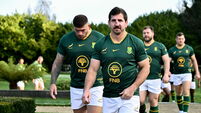Suitcase Number Seven: a memoir of Munster’s forgotten hero
But, don’t go running off to check how many caps he gained for his country.
While Cleary was one of the great scrum-halves of his generation, ill fortune declared he never got to pull on the green jersey in a full international.
There were good reasons for this - like the presence of the great John O’Meara, as well as Andy Mulligan, a British and Irish Lion - and some not so good. Also, replacements weren’t allowed in those days.
Tom lived with his disappointment and enjoyed the many compensations the game had to offer - such as touring South Africa with the Irish team in 1961, winning three Munster Cup medals with Bohemians and captaining and playing for Munster for years.
And it was that tour to South Africa in ’61 that prompted a recently published book on his life, Suitcase Number Seven, written by his niece Ursula Kane Cafferty.
The title comes from the number of the suitcase presented to Cleary before the tour and which contained his worldly possessions when discovered after his death in 1997.
It was on examining the contents of the case that his niece said she knew she had to write the book.
A fascinating story of how a gifted sportsman slipped from a position of considerable esteem is told as a fictional memoir.
We learn how Tom Cleary grew up in Carrick-on-Suir, Co Tipperary, and from an early age proved himself an outstanding rugby and tennis player and a golfer of considerable prowess.
He spent his secondary school days boarding at Castleknock where he was a member of the team that won the Leinster Schools Senior Cup in 1946/’47 - a side that also included players such as Brendan Guerin, Leo Lynch, William (Boldy) O’Neill and international golfer John Nestor.
A year later, he captained the Castleknock side that reached the final.
The Cleary graph continued on the up and up.
On leaving school, he worked for an accountancy firm in Limerick and so began his 13-year association with the Bohemian club.
He and Mick English formed one of the finest half-back partnerships in the game and were largely responsible for the emergence of Bohs from almost obscurity to winning three Munster Cups between 1958 and 1962. They also played together many times for Munster but, unfortunately, not once for Ireland.
Life was not as good for Tom once he retired from the rugby arena.
He moved to Mullingar to live with his sister Helen and made close friends there, many of whom shared his liking for the black stuff and a good chat. But then the graph went on the slide.
“Some time after his funeral, the time came to go through Tom’s things. He didn’t have much. One of his suitcases was heavy, though,” Ursula says.
“His brother Gerry brought it to the sitting room. We sat on the high, hard, old-fashioned couch, Gerry and his wife Ann, Helen and I, as we read the story and saw the long-forgotten pictures of Tom’s life, the joys, sorrows, triumphs and disappointments.
“The bottom of the case was lined with a green plastic property bag from the hospital where I worked and where Tom had been treated a year earlier. A shiver ran down my spine as I realised Tom had known he was dying during the past year of his illness and had sorted out what he wanted us to have and see. His story. It was then I knew I had to write this book.”
If you knew Tom Cleary as an individual or as a player, you will love this book. If you are only hearing of him now, you will love it for the story and the sensitivity of the writing.















